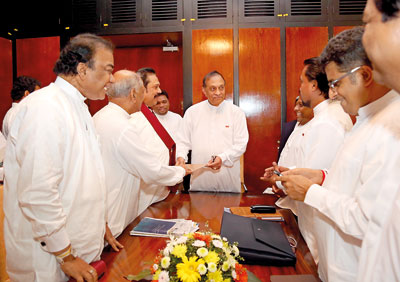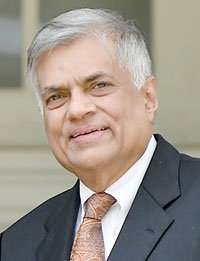Columns
The ominous cracker lit behind Joint Opposition’s ‘puswedilla’
View(s):Elated, no doubt, by winning the popular vote at last month’s local government polls, the joint opposition’s new move this month was to take its battle to the UNP heartland and make a bid to end its leader Ranil Wickremesinghe’s long stay atop Sri Kotha’s pinnacle.
The strategy deployed was to bring a no-confidence motion in the House against his position as prime minster of the government.

FORMAL HAND OVER OF NO CONFIDENCE MOTION: Lose a battle to win the war
If it succeeds on April 4 — when it will be taken up for debate and vote– it would mean curtains for Ranil both as premier and as chief of the UNP. As the longest reigning leader of the party, his twenty-four-year tenure of office as leader had not made the earth move for the UNP. In fact, it had been a long record spell of drought only broken by a two-year shower in 2001 and a three year monsoon presently being experienced, which has never fully set in, accompanied with only intermittent rain. During these two periods, the UNP has only succeeded in playing second fiddle to an SLFP presidency.
But if the UNP membership had been disgruntled with his leadership, the move to oust him from the leadership should have come from within the party. But Ranil is no pushover. And the failed putsch against his leadership a few years ago bear witness to his genius to ward off challenges from the ranks. This time however it has come from without, not within.
On Thursday, the joint opposition handed over the no-confidence motion to the Speaker. It listed 14 charges against the prime minister as being the reasons why he had lost the confidence of the House. And what were they? The main charges are:
placing the Finance Ministry under the purview of the Prime Minister with the intention of committing the bond scam,
Rather a long shot, isn’t it, to establish intention? One that will never stand up in court though it may well make do on a political platform. There may have been salient reasons why this was done. To make such a wild claim that it was done solely to empower him to execute the biggest bank robbery is simply not on. Or fair to a man who has conducted himself so scrupulously and earned the title of Mr. Clean. A fitting epithet bestowed upon him not only by the masses but even by his worst foes.
To allege that he placed the Central Bank under his purview with an ulterior motive, with an evil intention to execute a major bond scam is nothing more than a bizarre attempt to make the hunter the hunted.
appointing Singaporean Arjuna Mahendran to the post of Governor of the Central Bank, directly involved in the Treasury bond scams,
Unlike appointments made by the previous regime on the grounds of nepotism, Arjun Mahendran had the necessary credentials for the job.
A Royal College old boy who had graduated from Balliol College, Oxford, he had served for ten years in the Central Bank from 1983 to 1991. Then served as the Managing Director and Chief Investment Strategist-Asia at HSBC Private Bank. He was responsible for research and analysis of markets in the Asia Pacific. He served as Chief Investment Officer-Wealth Management division at Emirates NBD. He then led the analytics team in interpreting market economics and developing investment strategies for HSBC’s clients in the region. From 2001 to 2004 – during the period Ranil Wickremesinghe was Prime Minister in President Chandrika Kumaratunga’s government — served as Chairman and Director-General of the Board of Investment of Sri Lanka. Thereafter, he served as Chief Economist and Strategist – Asia Pacific at Credit Suisse Group AG and was its Head of Research for Asia Pacific since October 2006. He became a Singapore citizen the same year.

RANIL: No pushover
With such a CV, Ranil Wickremesinghe can hardly be faulted for making Mahendran — whom he had first met in 1991 and offered him a job in his Industries Ministry which was immediately accepted — the Government’s Banker in January 2015. After all, no crystal ball was in the prime minister’s possession or powers of clairvoyance hidden deep in his psyche to foretell what the future held when the fateful appointment was made.
appointing the Pitipana committee comprising his friends to exonerate those responsible for the scam,
Certainly, Ranil may have known the men he appointed to the committee. After all, one does not appoint one’s sworn enemies. But all who were appointed were qualified people though acquaintances they may have been; and to insinuate that these members of the committee, all attorneys-at-law, were Ranil’s lackeys entrusted with the task of doing a hatchet job for Ranil and to whitewash him is to insult their moral rectitude and traduce their honour.
misleading Parliament by giving false statements on the bond commission on March 17, 2015,
What these false statements were are not spelt out in the no confidence motion
violating financial regulations
Again, no mention is made of what financial regulations have been violated
failure to arrest the rising cost of living
If the failure to arrest the rising cost of living was to form a charge to bring a no confidence motion against a prime minister, then no prime minister today or in the future will survive for long in office. Apart from the fact that the Maithri-Ranil Government dramatically reduced the prices of petrol and diesel no sooner they came to office in January 2008; and brought it in line with the then trending world oil prices – which the Rajapaksa regime had kept artificially high despite oil hitting rock bottom prices — cost of living is also affected by world trends
Failure to respond promptly to the incidents in Kandy and ensure the security of the citizens of the country, while holding the Ministry of Law and Order.
Ranil Wickremesinghe was appointed the Law and Order Minister on the 25th of last month. In the lackadaisical cabinet reshuffle, which had been touted as one that would bring dramatic change, his was the only significant appointment. But, alas, even that was only to be a stopgap appointment until the return of Field Marshall Fonseka to the island.
On March 4, due to an altercation on the Teldeniya road which happened on February 22 over the refusal of a lorry driver to give way to a tooting three wheeler, a Sinhala mob descended on the towns of Teldeniya and Digana. They came incognito, their heads capped and their faces masked. It is now confirmed that this was no Sinhala racial attack on the Muslims but an organised attack by a group calling itself the Mahason Balakaya, urged by a mysterious hand to burn the hills down in racial flames.
President Sirisena declared a state of emergency and Prime Minister Wickremesinghe did the needful to end the violence within a week. Hardly the sort of immediate action that deserves condemnation and hardly the stuff to found a basis for the no-confidence motion, is it? Already over 200 culprits have been arrested, including the leaders of the mob which is more than can be said of the apathetic reaction of the previous regime when racial violence broke out in Beruwela in 2014.
 Out of the 14 charges levelled against the PM, 12 evolve around the bond scam. It seems that the bond scam is the only bell the joint opposition can put around Ranil’s neck in their attempt to crucify him with the no-confidence motion. But almost all had been answered by Ranil at the Presidential Bond Commission inquiry which had led to him being exonerated by that Commission which comprised two sitting Supreme Court judges and a former Deputy Auditor General.
Out of the 14 charges levelled against the PM, 12 evolve around the bond scam. It seems that the bond scam is the only bell the joint opposition can put around Ranil’s neck in their attempt to crucify him with the no-confidence motion. But almost all had been answered by Ranil at the Presidential Bond Commission inquiry which had led to him being exonerated by that Commission which comprised two sitting Supreme Court judges and a former Deputy Auditor General.
During their campaign to collect sufficient signatures to place it for the Speaker’s consideration, JO MPs were claiming triumph. It was part of the sinister strategy to not only show to the public but also more importantly to show and convince other MPs on the fence to join the uprising to breathe the invigorating Mahinda air, the unstoppable Mahinda sulange or be gone with the wind.
MP Udaya Gammanpila claimed they were confident that 22 UNP members would support the motion. MP Dallas Allahaperuma said the people made it clear that they had lost confidence on the Prime Minister on February 10, 2018, at the Local Government Elections. He claimed that more than 69 percent of the people had rejected the Prime Minister and the Government at the last local government elections without realising that, on the same basis, more than 55 percent of the masses had voted against Rajapaksa.
On March 14, even former President Mahinda Rajapaksa chipped in to raise spirits among the ranks and give impetus to the recruiting drive. He said that many Ministers had expressed willingness to support the proposed no-confidence motion against Prime Minister Ranil Wickremesinghe. “They are close to the Prime Minister,” he said and expressed confidence that the no-confidence motion would succeed. “He will be toppled. He will have to go soon.”
But wouldn’t hopes raised to fever pitch amongst the Pohottuwa ranks that the final hour had come for Ranil to make his exit from the political arena and for Mahinda to make his entrance have fallen flat when it was revealed this week that the Joint Opposition had been able to muster only 51 out of 54 of their own MPs to place their signatures on the dotted line? With three of their own reneging on their promise to support the motion? Amongst the three, there was one notable figure: the MP from Kurunegala, the protaganist
For all their proud boasts that 30 odd UNP MPs will cross over and sign, none did. For all their claims that a great number of SLFP MPs will join the Joint Opposition effort to oust Ranil Wickremesinghe, even after President Sirisena had stated that anyone who wished to do so was free to do so, only four did. The final tally: 54 out 225 MPs.
The expected exodus from the SLFP and UNP MPs didn’t materialise. JO’s Promised Land held no great promise to sway their loyalties and make them cross the divide that had opened up between the UNP and the SLFP seas.
The Joint Opposition was staring in the face of defeat but they still went ahead and presented to the Speaker the no-confidence motion with only 54 supporting it. Why?
Contrary to the general opinion voiced on the streets by Joint Opposition supporters, the no-confidence motion was not designed and presented to throw Ranil out as prime minster and make Mahinda fill the slot. Mahinda Rajapaksa had already announced that even if he were to be offered the premiership by Sirisena he would not accept it. “I don’t want to be a ‘ping’ prime minister under Sirisena,” he had repeatedly declared. Quite rightly so. Why should he, when he holds all the picture cards against Sirisena’s low denomination hand? It was an all or nothing poker game he was playing. Where the winner takes all.
What will transpire on April 4 when the no-confidence motion is scheduled to be taken up for debate cannot be foretold, especially considering the vacillating nature of Lanka’s political breed. It is anyone’s guess as to what will be its outcome. But with the UNP MPs signing a motion of confidence in their leader en masse on Thursday, the bets are on the no-confidence motion being defeated.
But will the Joint Opposition masterminds consider it as a defeat but as a means to an end? True, they will face the embarrassment of defeat, suffer egg on their face after all the boasting made that the majority of Parliament would join them to topple Ranil from his prime ministerial pedestal. Though that may not happen on April 4, the whole purpose of bringing the no-confidence motion would have been served. To rock the UNP boat and create a sudden leadership crisis in the UNP to wreck its morale and render it divided.
As Dinesh Gunawardena, the parliamentary leader of the Joint Opposition, said this week, the no-confidence motion ‘would create a crisis for the Government.’ It was not a case to win the no-confidence motion. It was part of the grand strategy to risk losing a battle to win the war.
Therein, perhaps, lies the secret of the Joint Opposition strategy. Already they have succeeded in breaking up the SLFP and UPFA whilst still professing to be members of the SLFP and the UPFA, of which the SLFP is the major constituent. Of the UPFA’s 95 MPs in Parliament today they have successfully kraaled the majority to their camp. They have broken the backbone of Sirisena and left him forlorn and alone in the wilderness, surrounded by a minority whose trust and loyalty to him can no longer be guaranteed. In fact, it never was from day one.
Now it’s the turn of the UNP. Most probably, the no-confidence motion would turn out to be a puswedilla. But behind the damp squib, a cracker has already been lit to render the UNP aflame with dissension.
With the young Turks in the party thirsting for real power and braying for the leader’s blood, the time it seems, had come to put the cat amongst the pigeons. And create dissension amongst those jostling for power and positions. To their credit, the strategy seems to be working. Though the party seems united for now, there is a bad moon rising from its depths.
Suddenly the UNP has gone into a spin. An outsider has been allowed to cast the spanner to its works. And in that cranked state to make it think, and think radically where it had gone wrong all these years. But even now, is it thinking right?
In a way, the Joint Opposition’s no-confidence motion could not have come at a better time to shake the UNP hierarchy from its slumber. In fact, it may have been a blessing in disguise. A favour from the foe. For the UNP to get its act together. Before it’s too late.
It’s a long overdue wakeup call for both Ranil and his party. Merely changing positions in the party structure with the same old faces in different positions will not do. It’s time to keep its promises to the people. Or else it will not have many miles to go.
| Guess who came to dinner but didn’t stay to dine I am their leader: I must follow them; but he didn’t On Thursday when the Joint Opposition handed over the no-confidence motion against Ranil Wicremesinghe to Speaker Karu Jayasuriya, its defacto head, former President Mahinda Rajapaksa, was at the helm of affairs and was photographed, along with JO’s de jure parliamentary head Dinesh Gunawardena engaged in the act of the motion’s formal delivery.  Mahinda: Talk yes, but signing no To all sense and purpose, it was clear that the former president gave his fullest backing to the no-confidence motion. In fact, last week he had said he would sign it if the others of his Joint Opposition party sign it. Fifty-one JO MPs out of the JO cadre of 54 signed it. Three refused t sign it. One of them was its leader. Mahinda Rajapaksa seems to have cottoned on to a piece of French history. The French politician Alexandre-Auguste Ledru-Rollin during the French Revolution saw a protest march pass by and is attributed with the quotation, ‘where are they going, I am their leader, I must follow them.’ Rajapaksa adopted the same stance and waited for his followers to sign the no-confidence motion against Ranil before he, as their leader followed them, and put his own hand upon the document. Only this time, he didn’t follow his sheep. And didn’t put his signature on it in support of the motion. Perhaps it’s due to nostalgic memories that suddenly surged of all the cups of coffee they shared together once upon a time that made him stay his hand and not ink the death warrant. | |
 Mahasona: Lanka’s most feared demon of the cemetery Who the devil is Mahason They claim to speak and act and do their worst on behalf of the Sinhala race. But what made them choose the name Mahason? He is supposed to haunt graveyards, rocks, hills, and junctions where three roads meet. In fact, his name itself means ‘great demon of the cemetery’. He is depicted as one who rides a pig, with a pike on his left hand and a buffalo or elephant on his right hand whose blood he squeezes out to drink when thirsty. Well, he is also supposed to be 122 feet in height. He is the most feared yaka in Sinhala folklore and figures prominently in exorcism ceremonies. Thus, it is clear that those who could conjure up his name to represent the Sinhala Buddhist and appear under that appellation to defend the Sinhala race should undergo psychiatric treatment and get their mindset sorted out. If that fails to do the trick, be subjected to an all night bali thovil ceremony to exorcise the Mahasona in them. |


Leave a Reply
Post Comment